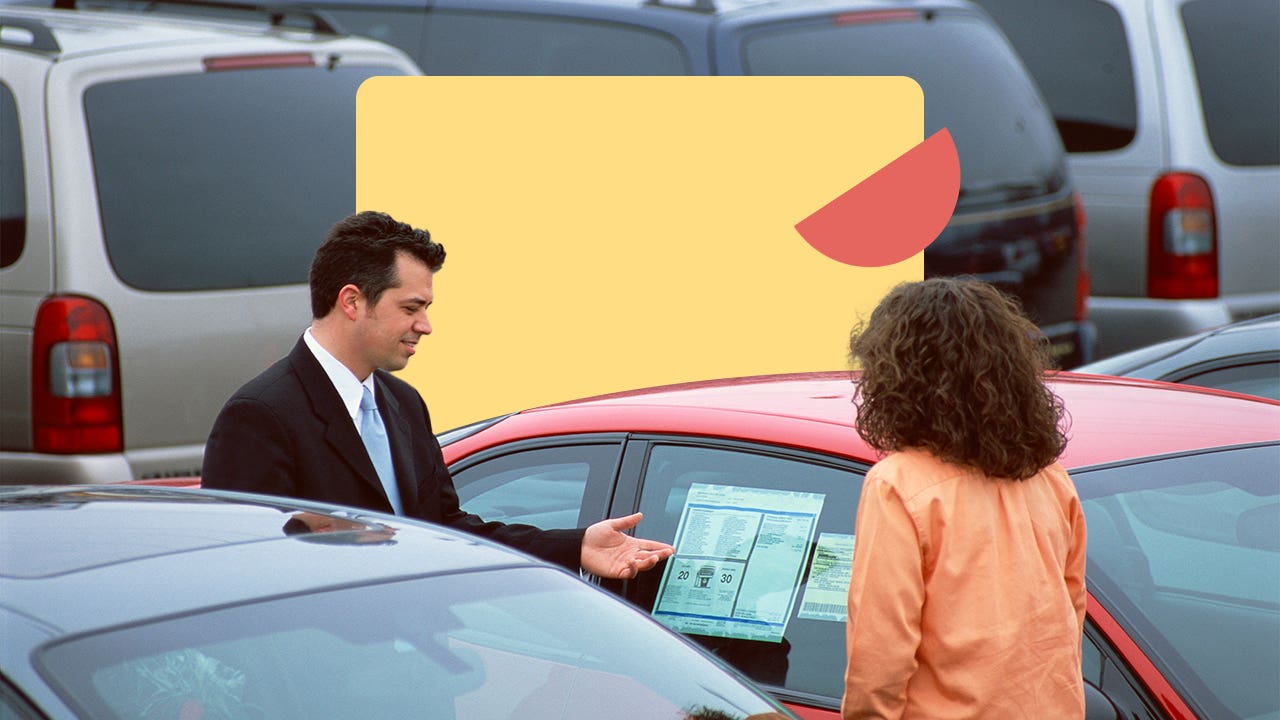How to buy a used car from a dealer or private party

The Bankrate promise
At Bankrate we strive to help you make smarter financial decisions. While we adhere to strict , this post may contain references to products from our partners. Here's an explanation for .
Key takeaways
- To ensure that you purchase a used vehicle you can truly afford, make a budget and stick to it. Many experts advise not to spend more than 20 percent of your take-home pay on monthly vehicle costs.
- Buying a certified pre-owned vehicle is an excellent option for those shopping at a franchise dealership.
- To secure the most competitive auto loan rate, get prequalified through a bank, credit union or online lender before going to the dealership.
Buying used is a great way to get behind the wheel of a vehicle for less. While used car prices are up compared to pre-pandemic, buying used is still far less expensive than buying new. The average used car price was $25,638 as of February 2024, compared to around $47,142 for new cars, according to Cox Automotive.
But saving money shouldn’t be the only priority on your list when considering a used car vs. a new one. To make your purchase a sound investment, know common red flags to watch for.
6 key steps to buying a used car
There is no way to guarantee that you will get a used car free of defects. However, you can take steps to minimize your risk and secure the best deal.
1. Make a budget and stick to it
Look at your budget and determine how much you can afford to spend monthly on a car loan. Experts recommend spending no more than 10 to 15 percent of your net (or take-home) pay on your car payment.
Use an auto loan calculator before starting your vehicle search so you have a firm understanding of your budget — and the interest rate and loan terms you can afford. If you’re planning to roll tax, title and registration costs into the loan, include them in the purchase price.
And don’t forget to factor in the cost of vehicle maintenance, fuel, insurance and repairs. You may need to adjust your budget to fit it all.
2. Research cars that fit your needs
Now that you have an ideal purchase price, research safe and reliable models that fit your needs and budget. Create a list of your top five options and choose a car based on reviews and safety ratings from the Insurance Institute for Highway Safety. Kelley Blue Book and Edmunds also offer reviews and ratings for used cars.
If you plan on buying a car from a franchise dealership, look at certified pre-owned options. CPO vehicles offer several advantages. Only vehicles in the best shape and condition qualify for CPO programs. They are generally under 5 years old, with low mileage and a clean vehicle history.
In addition, CPO vehicles often have a warranty from the manufacturer. You can also buy a private extended warranty if you find a perfect ride that isn’t CPO.
3. Get preapproved for financing
Before visiting the dealership or shopping for a vehicle from a private owner, consider getting an auto loan through a traditional bank, credit union or online lender.
Some lenders let you explore potential rates on their website through prequalification without affecting your credit score. Most allow you to apply for preapproval and receive a formal offer, so you have up to 30 days to shop. Preapproval does require a hard credit check but typically only temporarily dings your credit score.
Getting dealer financing may be tempting. But the dealer could try to pair you with a lender paying a heftier commission rather than another lender with a lower interest rate.
Walking into the dealership as a prequalified buyer shows the salesperson you are serious. It also gives you more leverage to negotiate both the vehicle’s sale price and financing terms.
4. Shop around for a car
Start exploring options for purchasing your future set of wheels. Here are some good starting points:
- Private party sellers: Purchasing from a private owner through Craigslist or Facebook Marketplace can work if you have a specific car in mind and don’t mind vetting the vehicle and seller yourself.
- Dealerships: Shopping in person at a dealership means enjoying expert assistance. Consider exploring available vehicles online ahead of time to see if anything interests you.
- Online retailers: Shopping online with platforms such as Carvana or CarMax allows you to browse a huge selection of vehicles, but you may not be able to test drive before buying.
Keep in mind: Proceed cautiously when purchasing from a private seller to ensure you avoid potential scams.
5. Fully research a car after test driving
Access the vehicle history reports for your top choices. You can visit Carfax or AutoCheck to pull this information using the VIN, or vehicle identification number, if the vehicle is from a private seller. Otherwise, the dealership should have the vehicle history readily available to review.
Consider contacting the car’s previous owner when buying a vehicle from a dealer. You can learn more about the car’s maintenance history and whether it has issues you should know about. Here are some of the best questions to ask a seller:
- Can I see the service records?
- Can I have the vehicle independently inspected?
- How many owners have the vehicle had?
- Is the title clear?
The previous owner’s information can be found on the car’s title. You can also ask for the car’s VIN and then use that number to track down the vehicle’s previous owner through websites like Carfax, which provides vehicle ownership history reports.
Also, have the car independently inspected by a mechanic certified by Automotive Service Excellence. If there are issues, ask that the seller cover the repair costs or reduce the selling price. You should also check for safety issues and recalls, which can be done on the National Highway Traffic Safety Administration’s website using the VIN.
6. Negotiate and finalize the purchase
The final step is to seal the deal. Now that you know your budget, rates and average vehicle prices, negotiate a purchase price that works for both parties.
If you’re financing the car, focus on the purchase price, not the monthly payment. This helps you avoid getting trapped into an extended loan that increases interest costs. You must also finalize the loan by contacting the lender to sign documents.
Key factors to consider when buying a used car
Test drive any vehicles that pique your interest and know what to look for when viewing a used car. Some of the top items to review include:
- The car’s body condition: Look for dents, rust and panels that don’t align properly, which may indicate poor assembly or repair work.
- Reliability: Some vehicles have better reputations than others. Check Consumer Reports for any current recalls or typical maintenance issues to ensure you aren’t purchasing a car fraught with issues.
- Suspension: Make sure the car sits level.
- Lights: Inspect all the lights to ensure they work and are not cracked or foggy due to moisture.
- Safety features: Even older vehicles should have equipment to keep you safe. Look out for features like automatic braking or adaptive cruise control.
- Pedals: Look at the gas pedal, brake and clutch to ensure the rubber is not overly worn. If a car is advertised with low mileage, the rubber on these pedals should not be worn through.
What to watch out for when buying used
A used car could be right for your finances. Still, there are pitfalls to remember. Beware of:
- Cars with salvage titles, which the insurance company has declared a total loss.
- Private sellers or dealers that aren’t open to you having a pre-purchase inspection done on the vehicle.
- Private sellers who try to rush you into purchasing the vehicle.
- Vehicle history reports with limited maintenance records.
If you encounter a salvage title or limited maintenance records, ask more questions and conduct research before making a final decision. However, if a private seller or dealer does not let you conduct a pre-purchase inspection or you’re feeling rushed into a purchase, it may be best to walk away altogether.
The bottom line
Purchasing a used car can save you money. But before making such a purchase, factor insurance and maintenance into your budget and then research your car options carefully.
To get the best deal on a used car, shop around for auto loan rates and get preapproved. Also, consider trading in your current vehicle and making a larger down payment to get a more affordable monthly payment.
Most importantly, have the car inspected to ensure it’s safe and reliable before sealing the deal.
Related Articles



